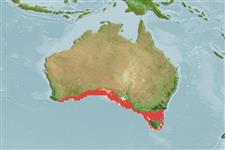分類 / Names
俗名 | 同種異名 | Catalog of Fishes(屬, 種) | ITIS | CoL | WoRMS | Cloffa
Elasmobranchii
板鰓亞綱 (鯊魚與魟魚) (sharks and rays) >
Orectolobiformes (Carpet sharks)
鬚鯊目 (Carpet sharks) >
Parascylliidae (Collared carpet sharks)
喉鬚鮫科 (Collared carpet sharks)
Etymology: Parascyllium: para (Gr.), near, i.e., presumed to be related to Scyliorhinus (now in Scyliorhinidae): skylion, Greek for dogfish or small shark (See ETYFish); ferrugineum: Latin for rust-colored, referring to dark brown spots on sides and fins (See ETYFish).
Environment: milieu / climate zone / depth range / distribution range
生態學
海洋 居於水底的; 深度上下限 5 - 150 m (Ref. 6871). 亞熱帶的; 31°S - 45°S, 117°E - 149°E (Ref. 54700)
Eastern Indian Ocean: endemic to Australia.
東印度洋: 澳洲的特有種。
Length at first maturity / 大小 / 重量 / 年齡
Maturity: Lm ?, range 60 - ? cm
Max length : 80.0 cm TL 雄魚/尚未辨別雌雄; (Ref. 6871)
Found on the continental shelf; on or near the bottom; also close inshore near rocks and river mouths. Occurs on beds of algae on reefs or seagrass; also hides in rocky caves and ledges during the day. Feeds on bottom-dwelling crustaceans and molluscs (Ref. 43278). Oviparous (Ref. 6871, 43278).
棲息於大陸棚了; 在底部上面或附近; 也在岩石與河口附近的近岸。 生活於在礁或海草上的藻類的床; 也躲在中岩石的洞穴與岩架在白天期間。 (參考文獻 43278) 卵生的.(參考文獻 6871)
Life cycle and mating behavior
成熟度 | 繁殖 | 產卵場 | 卵 | 孕卵數 | 仔魚
Oviparous, paired eggs are laid. Embryos feed solely on yolk (Ref. 50449).東印度洋: 澳洲的特有種。
Compagno, L.J.V., 1984. FAO Species Catalogue. Vol. 4. Sharks of the world. An annotated and illustrated catalogue of shark species known to date. Part 1 - Hexanchiformes to Lamniformes. FAO Fish. Synop. 125(4/1):1-249. Rome, FAO. (Ref. 247)
IUCN 瀕危狀態 (Ref. 130435: Version 2024-1)
無危 (LC) ; Date assessed: 09 May 2015
人類使用
漁業: 沒有興趣
工具
特別的報告
下載 XML
網路資源
Estimates based on models
Preferred temperature (Ref.
123201): 14.6 - 18.3, mean 16.8 °C (based on 158 cells).
Phylogenetic diversity index (Ref.
82804): PD
50 = 0.5352 [Uniqueness, from 0.5 = low to 2.0 = high].
Bayesian length-weight: a=0.00389 (0.00180 - 0.00842), b=3.12 (2.94 - 3.30), in cm total length, based on all LWR estimates for this body shape (Ref.
93245).
營養階層 (Ref.
69278): 3.7 ±0.6 se; based on size and trophs of closest relatives
回復力 (Ref.
120179): 低的, 最小族群倍增時間4.5 - 14 年 (Fec assumed to be <100).
Fishing Vulnerability (Ref.
59153): Moderate to high vulnerability (52 of 100).
Nutrients (Ref.
124155): Calcium = 13 [3, 58] mg/100g; Iron = 0.259 [0.069, 0.730] mg/100g; Protein = 18.8 [16.7, 20.8] %; Omega3 = 0.412 [0.185, 0.897] g/100g; Selenium = 11.8 [3.6, 31.5] μg/100g; VitaminA = 10.5 [3.3, 31.9] μg/100g; Zinc = 0.442 [0.215, 0.796] mg/100g (wet weight);
